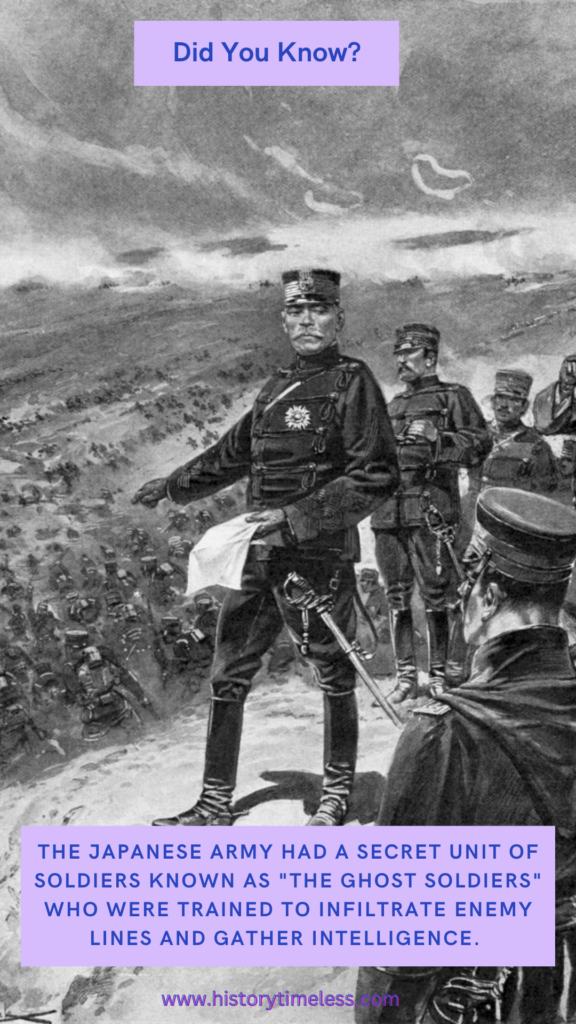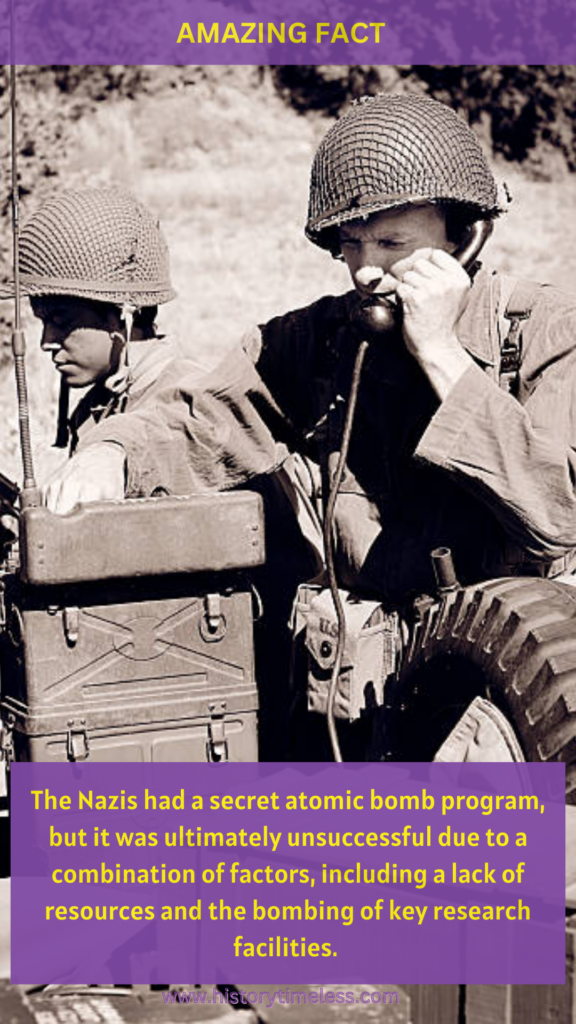World War II was a pivotal event in modern history, shaping the world as we know it today. The war was marked by unimaginable atrocities, courageous sacrifices, and unprecedented technological advancements.
In this list, we will delve into 30 mind-blowing facts about WWII that will change your perspective on this pivotal moment in history. From secret operations to surprising alliances, these facts will leave you amazed.
1. The Phantom Army
The Allies created a phantom army in England to deceive the Germans about the location of the D-Day invasion. This phantom army, code-named “Operation Quicksilver,” was made up of inflatable tanks and fake radio transmissions.
The operation was successful in convincing the Germans that the invasion would take place at the Pas-de-Calais. This clever tactic played a significant role in the success of the D-Day invasion.
2. Hitler’s Secret Plan
Hitler had a secret plan to destroy the British economy by flooding the country with forged banknotes. The plan, code-named “Operation Bernhard,” involved printing millions of counterfeit pounds and distributing them throughout Britain.
Although the plan was ultimately unsuccessful, it highlights the creative and often bizarre strategies employed by the Axis powers.
3. The Ghost Soldiers
The Japanese army had a secret unit of soldiers known as “The Ghost Soldiers” who were trained to infiltrate enemy lines and gather intelligence.

These soldiers were experts in disguise and deception, often going undercover as locals or even enemy soldiers. Their bravery and cunning played a significant role in Japanese military operations.
4. Churchill’s Secret Bunker
Winston Churchill had a secret bunker built beneath the streets of London, known as the “Cabinet War Rooms.”
This bunker served as the prime minister’s emergency headquarters during the war, equipped with a bed, a map room, and a telephone switchboard. It was here that Churchill coordinated Britain’s war effort and made many key decisions.
5. The Dambusters Raid
The British Royal Air Force (RAF) conducted a daring raid on German dams in 1943, using a revolutionary new bomb that bounced across the water to reach its target. The “Dambusters” raid, as it came to be known, was a groundbreaking example of British ingenuity and precision bombing.
6. Japanese Balloon Bombs
The Japanese launched a series of balloon bombs towards North America, hoping to start forest fires and cause widespread chaos. Although most of the balloons were intercepted or failed to reach their targets, the attack remains one of the most unusual and innovative tactics of the war.
7. Operation Mincemeat
The Allies conducted a clever operation in which they dressed up a corpse in a Royal Marine uniform and planted fake documents on it, making it appear as though the body was that of a high-ranking officer who had been carrying sensitive information.
The Germans took the bait, and the operation helped to convince them that the Allies were planning to invade Greece rather than Sicily.
8. The Navajo Code Talkers
The US Marine Corps recruited a group of Navajo soldiers to develop a secret code based on the Navajo language. The “Code Talkers” were able to transmit vital information without being intercepted by the enemy, playing a crucial role in several key battles.
9. The Bletchley Park Codebreakers
A team of codebreakers at Bletchley Park in England worked tirelessly to crack the German Enigma code, eventually succeeding in deciphering the complex encryption. The codebreakers’ work gave the Allies invaluable insights into German military operations and helped turn the tide of the war.
10. The Soviet Union’s Female Pilots
The Soviet Union had a squadron of female pilots, known as the “Night Witches,” who flew bombing missions against the Germans. These brave women pilots conducted thousands of sorties, earning numerous awards and decorations for their bravery.
11. The British Spy Who Infiltrated the Nazis
A British spy named Eddie Chapman infiltrated the Nazi party and gained the trust of high-ranking officials, including Hitler himself. Chapman’s courageous exploits provided valuable intelligence to the Allies and helped to undermine the Nazi war effort.
12. The War’s Most Decorated Soldier
Audie Murphy, an American soldier, became the most decorated soldier of the war, earning an astonishing 33 medals and awards for his bravery. Murphy’s heroism in combat and his commitment to his fellow soldiers have become legendary in American military history.
13. The Ghost Ships
The Allies created a fleet of “ghost ships” by disguising merchant vessels as warships, complete with fake guns and fake superstructures.
The ghost ships were used to deceive the Germans about the location and strength of the Allied fleet, helping to protect vital convoys and disrupt German naval operations.
14. The Nazis’ Secret Antarctic Base
The Nazis had a secret base in Antarctica, known as “New Schwabenland,” where they conducted scientific research and experimented with new technologies. The base was abandoned at the end of the war, but its remnants remain a fascinating and little-known chapter in the history of WWII.
15. The Soviet Union’s Massive Human Losses
The Soviet Union suffered the highest number of casualties of any country during the war, with estimates ranging from 20 to 30 million dead. The sheer scale of the Soviet losses is a testament to the brutal and devastating nature of the war on the Eastern Front.
16. The P-51 Mustang’s Impact
The P-51 Mustang, an American fighter plane, played a crucial role in the war by escorting bombers deep into enemy territory and providing air support for ground troops. The Mustang’s range, speed, and maneuverability made it one of the most feared and respected planes of the war.
17. The Nazis’ Atomic Bomb Program
The Nazis had a secret atomic bomb program, but it was ultimately unsuccessful due to a combination of factors, including a lack of resources and the bombing of key research facilities.

The Nazis’ pursuit of nuclear weapons remains a haunting reminder of the devastating consequences of scientific progress without moral responsibility.
18. The British SAS’s Early Raids
The British Special Air Service (SAS) conducted a series of daring raids behind enemy lines, targeting German airfields, supply depots, and communications networks. The SAS’s early raids helped to disrupt German operations and paved the way for the development of modern special forces.
19. The Soviet Union’s Women Snipers
The Soviet Union had a contingent of female snipers who fought bravely on the Eastern Front, earning numerous awards and decorations for their marksmanship and courage. These women played a significant role in the Soviet war effort and helped to challenge traditional gender roles in the military.
20. The Allies’ Operation Plunder
The Allies conducted a massive operation, code-named “Operation Plunder,” to cross the Rhine River and push deep into Germany. The operation involved thousands of troops, tanks, and aircraft, and marked a crucial turning point in the war.
21. The Japanese Surrender
The Japanese surrender was facilitated by the dropping of atomic bombs on Hiroshima and Nagasaki, as well as the Soviet invasion of Manchuria. The surrender marked the end of the war and the beginning of a new era in international relations.
22. The Nazis’ V-2 Rocket Program
The Nazis developed a program to build V-2 rockets, which were the first long-range guided missiles. The V-2 rockets were used to attack British cities, causing significant damage and loss of life.
23. The British Double Agents
The British had a network of double agents who fed false information to the Germans, helping to deceive them about the location and timing of key operations. The double agents played a crucial role in the success of the D-Day invasion and other key battles.
24. The Soviet Union’s Partisan War
The Soviet Union had a massive partisan movement, with hundreds of thousands of civilians fighting behind enemy lines.
The partisans conducted guerrilla warfare, sabotage, and intelligence gathering, helping to weaken the German army and support the Soviet war effort.
25. The Allies’ Operation Market Garden
The Allies conducted a massive airborne operation, code-named “Operation Market Garden,” to capture key bridges and roads in Holland. Although the operation was ultimately unsuccessful, it marked a significant effort to liberate Western Europe from German occupation.
26. The Japanese Kamikaze Pilots
The Japanese had a contingent of kamikaze pilots who flew suicidal missions against Allied ships and aircraft. The kamikaze pilots were motivated by a combination of patriotism, loyalty, and a desire to die honorably.
27. The Nazis’ Concentration Camps
The Nazis established a network of concentration camps, where millions of people were imprisoned, tortured, and killed. The concentration camps remain a haunting reminder of the horrors of the Holocaust and the devastating consequences of racism and hatred.
28. The Soviet Union’s Tank Production
The Soviet Union produced an astonishing number of tanks during the war, with estimates ranging from 80,000 to 100,000. The Soviet tank production helped to offset the losses on the Eastern Front and provided a crucial advantage in the war against Germany.
29. The Allies’ Operation Torch
The Allies conducted a massive operation, code-named “Operation Torch,” to invade North Africa and drive the Germans and Italians out of the region. The operation marked a significant turning point in the war, as it helped to secure key ports and airfields and paved the way for the invasion of Italy.
30. The War’s Global Impact
The war had a profound impact on the world, shaping international relations, global economics, and cultural identity.
The war marked the emergence of the United States and the Soviet Union as superpowers, and paved the way for the Cold War and the modern era of global politics.
Peruse More Fascinating Discoveries:
30 Shocking Atomic Bomb Facts You Need to Know!
25+ Little-Known Facts About World War I That Will Shock You
26 Insane Facts That Will Leave You Speechless





